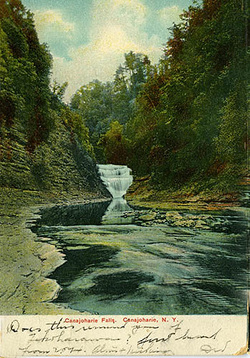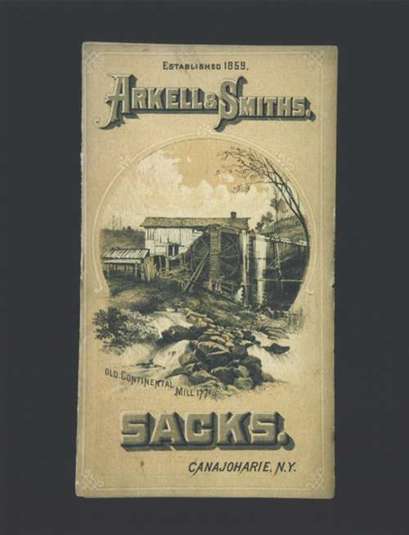Canajoharie, NY

Canajoharie is a small village on the Mohawk River/Erie Canal in Montgomery County in upstate New York. Current village population is 2,300; the larger geographic Town of Canajoharie has a population of 3,910; our school district population is 6,196.
The name "Canajoharie" is a transliteration of a Mohawk Indian word meaning "the pot that washes itself." The name refers to a geologic pothole in the bed of the creek that empties into the Mohawk River in the village.
The area was first settled by Europeans in the 1700s with the migration of the Palatine Germans into the Schoharie and western Mohawk Valleys. During the American Revolution Canajoharie was part of the frontier with ongoing fighting that would today be described as "horrific geurrilla warfare and ethnic cleansing" carried on between the patriots, the tories and their Iroquois allies.
Prosperity and development came after the Revolution. The opening of the Erie Canal in the 1820s brought rapid growth to many canal towns as it allowed for the transportation of agricultural products out and brought industry in. Agriculture has remained as a major industry, with dairy farming the predominant form. Sheep, beef, field corn and fruits and vegetables are also grown locally.
Industrial development in the late 1800s centered around the Arkell and Smiths sack factory. This company pioneered the development of the paper flour sack during the Civil War. Unfortunately, this industry left the village in the 1950s.
For all of the 20th century Canajoharie has been known as the home of the Beech-Nut factories. Started in the 1890s as a small firm that packaged the locally famous smoked ham of a village resident, the company expanded rapidly under founding president Bartlett Arkell to become a major player in the food processing industry. Today Beech-Nut manufactures its baby food in Florida, NY, and an independent candy maker, Richardson Brands, manufactures candy and other products in the old Beech-Nut plant #2.
With its stable industrial base the population of the area has remained relatively stable for 100 years. Agriculture, service sector industries including banking and insurance, and a growing interest in tourism, indicate a continued prosperous outlook for our village.
The name "Canajoharie" is a transliteration of a Mohawk Indian word meaning "the pot that washes itself." The name refers to a geologic pothole in the bed of the creek that empties into the Mohawk River in the village.
The area was first settled by Europeans in the 1700s with the migration of the Palatine Germans into the Schoharie and western Mohawk Valleys. During the American Revolution Canajoharie was part of the frontier with ongoing fighting that would today be described as "horrific geurrilla warfare and ethnic cleansing" carried on between the patriots, the tories and their Iroquois allies.
Prosperity and development came after the Revolution. The opening of the Erie Canal in the 1820s brought rapid growth to many canal towns as it allowed for the transportation of agricultural products out and brought industry in. Agriculture has remained as a major industry, with dairy farming the predominant form. Sheep, beef, field corn and fruits and vegetables are also grown locally.
Industrial development in the late 1800s centered around the Arkell and Smiths sack factory. This company pioneered the development of the paper flour sack during the Civil War. Unfortunately, this industry left the village in the 1950s.
For all of the 20th century Canajoharie has been known as the home of the Beech-Nut factories. Started in the 1890s as a small firm that packaged the locally famous smoked ham of a village resident, the company expanded rapidly under founding president Bartlett Arkell to become a major player in the food processing industry. Today Beech-Nut manufactures its baby food in Florida, NY, and an independent candy maker, Richardson Brands, manufactures candy and other products in the old Beech-Nut plant #2.
With its stable industrial base the population of the area has remained relatively stable for 100 years. Agriculture, service sector industries including banking and insurance, and a growing interest in tourism, indicate a continued prosperous outlook for our village.

